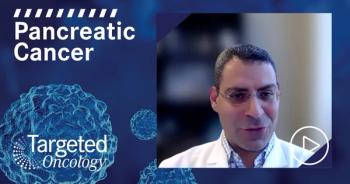
Evolving Treatment Approaches in Stage 4 Gastric Cancer
Daniel Catenacci, MD:We’ve come a long way in the treatment of stage 4 gastric cancer from not too long ago, where first-line therapy consisted of cisplatin and 5-FU, and that’s where basically palliative therapy stopped when that stopped working. We now know that there are a number of chemotherapy regimens that are effectiveplatinum-based, taxane-based, irinotecan-based therapies. We have targeted therapies for HER2-amplified patients who are receiving anti-HER2 therapy. We know that antiangiogenesis in the second-line setting is effective and improves survival and increases response rates.
We now have evidence that subsets will derive benefit from a checkpoint blockade immunotherapy, including microsatellite instability patients who account for about 3% of patients approved in the second-line setting or higher. And those that are microsatellite stable but have overexpression of PD-L1 by combined positivity score of more than 1 or are equal to 1% of cells in the third-line setting or higher. So, we’ve come a long way. The median overall survival has improved significantly as a consequence of that.
There are other interesting and exciting things on the horizonmoving checkpoint blockade into earlier lines of therapy. We are awaiting 2 large phase III studies to see if that will change the standard of care either in all-comers or in PD-L1expressing patients, or, at least, in patients who have very high levels of PD-L1, above 10% CPS.
We have other approaches, vaccines that are on the horizon, neoantigen vaccines, and other combination strategies with various targeted therapies. We’ve come to understand the biology of the cancer and the makeup of the cancer with molecular heterogeneitynot only between patients, but also within the patient—and that addressing those problems now may help us better target our therapies appropriately at any given time point to improve the patient’s outcome.
So, there’s a lot to look forward to and we’ve come a long way, and this patient here has benefited from some of these therapies.
Transcript edited for clarity.
A 61-Year-Old Woman With Stage 4 Gastric Cancer
November 2017
- A 61-year-old Hispanic woman presents to her PCP complaining of unexplained weight loss (15 lbs over 6 months), intermittent abdominal pain, fatigue, and recent onset of vomiting
- BMI: 23
- PE: negative for ascites
- Notable laboratory findings:
- HB: 11.2 g/dL
- LFT: WNL
- GFR: 100
- CEA, 18.4 ng/mL
- AFP, CA 19-9, and CA 125: WNL
- Upper gastric endoscopy: suspicious 7.2-cm ulcerative lesion involving the pyloric region
- Endoscopic ultrasound: suspicious lymph node
- Biopsy: confirmed poorly differentiated, gastric adenocarcinoma, diffuse histologic subtype; positive lymph node
- Molecular testing: HER2(-), MSI-stable, PD-L1 expression 0%
- CT of chest, abdomen, and pelvis: showed diffuse invasion of the gastric wall and visceral peritoneum, lymph node involvement, 1 hepatic lesion
- Staging: stage IV gastric adenocarcinoma, unresectable
- ECOG PS 0
January 2018
- The patient was started on fluorouracil and oxaliplatin (FOLFOX)
- Follow up CT at 3 months showed a response to systemic therapy
July 2018
- Patient reports increasing nausea, fatigue, and shortness of breath
- CT imaging at 7 months shows metastatic spread to multiple suprapyloric nodes and a new liver lesion
- LFT: mildly elevated; GFR: WNL; HB: 10.8 g/dL
- ECOG PS 1
- Patient is motivated to try another systemic therapy
- Treatment with paclitaxel/ramucirumab is planned







































